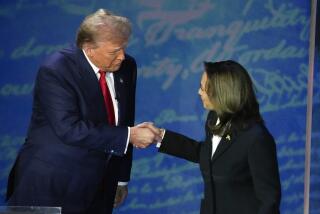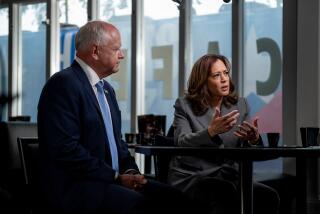Just 40% Paid ‘Very Close’ Attention to Hearings on Thomas, Poll Finds : Survey: Interest was on a par with that in the 1987 stock market crash but only half that in the 1986 Challenger disaster.
- Share via
WASHINGTON — It may have seemed as though the strange and disturbing confirmation hearings of Clarence Thomas over the weekend were all anyone was talking about, but early returns suggest that, although the televised sessions were riveting, life went on for most Americans.
According to a new survey released today, just 4 in 10 Americans said that they had been paying “very close” attention to the Thomas confirmation hearings, fewer than said they had paid very close attention to the breakup of the Soviet Union over the last month.
In general, this would put the level of interest in the resumed Thomas hearings on a par with news about the presidential campaign in October, 1988, the Bush Administration’s plan to deal with drugs in 1989 and the stock market crash in 1987, according to the Times Mirror News Interest Index, a monthly survey of public response to the news conducted by the Times Mirror Center for the People & the Press.
“Not many stories engage more than a third of the public very closely,” said Andrew Kohut, director of surveys for the center. But preliminary television ratings from the 25 largest cities suggest that, even if they were not paying close attention, Americans were tuned in.
On Friday night, preliminary ratings in the nation’s 25 largest cities for the hearings on ABC and NBC was 26.5, enough to drive the ratings for the Toronto Blue Jays-Minnesota Twins league championship baseball playoff Friday to 9.9, the lowest rated baseball playoff game in history.
“The initial ratings on Friday night were consistent with the pattern for events like the early days of the Persian Gulf War and the California earthquake,” said David Poltrack, vice president for research at CBS. “What makes this event extraordinary is that people tuned in beginning on Friday and stayed with it for significant hours throughout the weekend.”
Although it may have been an extraordinary television moment, the Thomas story was not so singular in the spectrum of public events. Such stories as the Supreme Court decision on flag burning in 1989 or the opening of the Berlin Wall or the 1988 farm drought all attracted higher levels of interest, the Times Mirror survey suggests, all at about the 50% level.
The most closely followed stories of all--the end of the Persian Gulf War, the invasion of Kuwait, the San Francisco earthquake--attracted the very close attention of about 70% of Americans, the survey’s history suggests. The Challenger disaster of July, 1986, hit 80%.
In all, 75% of Americans said that they were paying at least “fairly close” attention to the Thomas hearings--41% were watching very closely and 34% fairly closely--according to the index.
Still, a week earlier, 47% said that they had paid very close attention to the Soviet Union in the month since the failed coup there and cumulatively 79% had paid at least fairly close attention.
Several other stories were nearly as closely followed as the Thomas hearings, the survey found. Thirty-six percent of Americans, for instance, reported paying very close attention to news of the economy; 35% reported paying very close attention to the standoff in Baghdad between Iraqis and United Nations weapons inspectors and 31% reported paying very close attention to President Bush’s announcement of major nuclear arms reductions.
Before Anita Faye Hill’s press conference catapulted her charges of sexual harassment against Thomas onto the national scene last week, just 28% of Americans reported following the Thomas confirmation very closely over the last month, the survey found.
Amid public denunciations of the press--particularly by Thomas supporters--the Times Mirror survey suggested intense but divided feelings toward media coverage of the Thomas story.
Twenty-nine percent rated the coverage of the Thomas story excellent, slightly higher than usual for most stories. But 30% rated press coverage as only fair or poor, also higher than usual. Thirty-nine percent rated the coverage “good.”
That is still a more positive rating than some other recent controversial stories have received. Only 6% of Americans said that the press had done an excellent job of covering the abortion protests in Wichita, 43% rated that coverage good, 31% fair and 13% poor.
For those particularly attuned to news and public affairs, however, evidence suggests the Thomas hearings were something uniquely riveting.
In Los Angeles, for instance, public broadcasting station KCET (Channel 28) reported that it got the biggest ratings in its history Sunday with its gavel-to-gavel coverage from 9 a.m. to 11 p.m. The average audience throughout that period was about 210,000 homes, but it climbed as high as 595,000 homes on Sunday night, giving KCET the largest rating it has ever had.
The total TV audience for the Thomas hearings may never be known, Nielsen officials said, because there were so many people who viewed the hearings in groups in offices, bars and other sites not counted among the sampling of TV homes.
But network executives know that it cost them money. They estimated that the three broadcast networks lost between $15 million and $20 million in advertising revenue through preemptions of their regular entertainment programming on Friday night and over the weekend.
The Thomas hearings may also have helped daytime ratings. During daytime testimony Friday, for instance, the broadcast networks achieved higher ratings than usual for their programming, according to Alan Wurtzel, vice president in charge of research for Capital Cities/ABC. During the previous week, Wurtzel said, ABC had a 5.1 rating for its 11 a.m-1:30 p.m. daytime programming, CBS had a 6.0 rating and NBC had a 2.8 rating. Broadcasting the Senate hearings on Friday during those hours, ABC had a 7.2 rating, CBS had a 5.6 and NBC had a 4.3 rating.
“During the day on Friday, the networks started with a collective rating of about 15 and built to about a 20 rating,” Poltrack said. “That’s an audience of about 18 million homes at its peak during the day.”
On Saturday, when they preempted their regular Saturday-morning programming for children, the broadcast networks averaged a 16 rating on all three networks, Poltrack said. Normally, the broadcast networks receive a combined rating of 9.0 on Saturday mornings.
On Sunday night, when the broadcast networks returned to their regular programming, PBS and CNN apparently benefited.
“Looking at only selected markets so far for Sunday night, I would imagine that the combination of PBS and CNN could be somewhere between a 15 rating, which is extremely high for those networks,” Poltrack said. “They probably lowered the broadcast network ratings by 20% on Sunday night.”
From 6 to 8 p.m. Friday, almost 1.1 million Southland households were tuned to KNBC (Channel 4), KABC (Channel 7) or Channel 28 as Thomas was giving his emotional rebuttal to Hill’s testimony. It could not be determined how many more viewers were tuned to Cable News Network, or C-SPAN, cable’s commercial-free public affairs network, which also covered the hearings. Cable ratings are not included in local Nielsen figures.
More to Read
Sign up for Essential California
The most important California stories and recommendations in your inbox every morning.
You may occasionally receive promotional content from the Los Angeles Times.












